Significant events of the 1960s
Posted by Huw,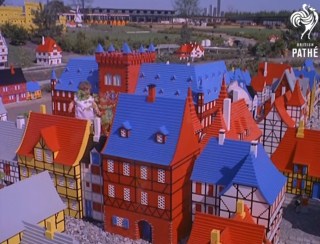
Vostok 1 launches the first man into space, President Kennedy is assassinated, Neil Armstrong walks on the moon, I was born... no, not those significant events of the 1960s, but those to do with LEGO.
In this article, which continues our short series of articles about the decade, I examine eight events that shaped the LEGO company, its products and surroundings into what they have become today, from a third factory fire to the opening of the first LEGOLAND.
1960: The factory burns to the ground, for the third time...
On Thursday the 4th of February 1960, the wooden-toy factory burned to the ground for the third time. I believe it was due to a lightning strike but I have not been able to corroborate that.
Following previous fires in 1924 and 1942 the factory was rebuilt to allow production to continue but by this time the company had another successful product line, one based on plastic, so a decision was needed whether to rebuild and continue with wooden toy production or to concentrate on manufacturing the plastic LEGO system exclusively. The latter was chosen, but it was not the last of wooden toys: two of the Christiansen brothers left LEGO to form their own companies to produce them, one of which was called BILOfix.
1961: The greatest invention since the wheel
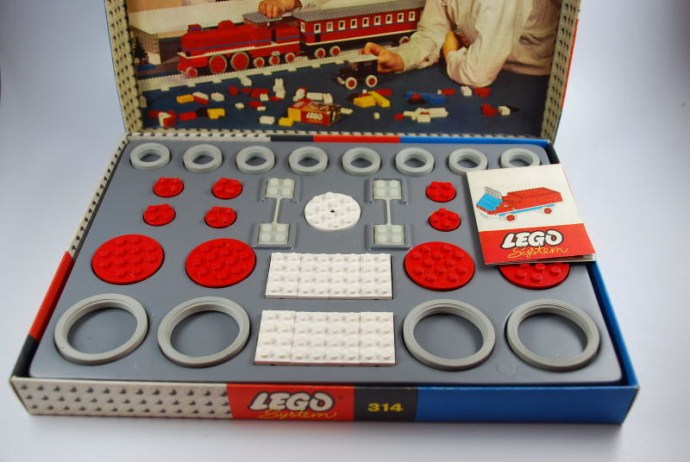 The 'LEGO System of Play' was launched in 1955 but it was not until 1961 that the wheel was developed, which then appeared in sets released the following year.
The 'LEGO System of Play' was launched in 1955 but it was not until 1961 that the wheel was developed, which then appeared in sets released the following year.
The first sets containing wheels were supplementary boxes but in 1963 a range of vehicles was introduced including 315 European Taxi.
This set, 314 Large & Small Wheels & Turn-Table, also released in 1963, contained everything needed to add wheels to your existing collection. Special 2x4 bricks with a hole in each end were provided to mount the metal-axled wheels, of which there are two sizes. The distinctive grey tyres perished, cracked and yellowed over time, particularly when played with and left on the wheels, so it is now hard to find good examples.
1962: ABS replaces cellulose acetate
Until now all LEGO bricks had been made from cellulose acetate, more commonly used as a backing for photographic film. However, it was not entirely suitable for the job because over time, when exposed to heat and humidity, it warped which led to difficulty stacking them and gaps between the bricks.
Recognising this, LEGO set up a department to look for alternatives, led by Swiss engineer Hans Schiess. The result was a switch to ABS, which produced much higher quality parts and also enabled improvements in the manufacturing process. Although the first ABS parts found their way into the products of 1963, it would not be until 1972 that cellulose acetate was phased out completely. [1]
ABS is still the primary plastic in use today.
1964: The first building instructions
 Although sets designed to build one specific model had been produced in the early 1960s they were few and far between and presumably simple enough to build without instructions.
Although sets designed to build one specific model had been produced in the early 1960s they were few and far between and presumably simple enough to build without instructions.
The first sets to include them were, apparently, released in 1964, such as this 324 House with Garage
1964: Billund Airport opens
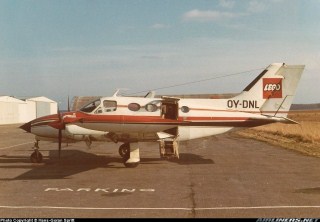 To allow the LEGO management team to travel efficiently now that the company was expanding all over Europe, a small short-haul aircraft was purchased. It was operated from airstrips in nearby towns until it began using a field just outside Billund, bordered by jumbo LEGO bricks.
To allow the LEGO management team to travel efficiently now that the company was expanding all over Europe, a small short-haul aircraft was purchased. It was operated from airstrips in nearby towns until it began using a field just outside Billund, bordered by jumbo LEGO bricks.
In 1962 a 1.6km runway was constructed and later that year agreement was reached with the local authorities to turn it onto a public airport. It was officially opened in 1964 by the Danish minister of transport. Some 60,000 people turned out to view a celebratory aerial display and apparently it was the cause of Billund's first (and probably only!) traffic jam when 10,000 cars left the area at once.
LEGO has operated a series of executive jets ever since although I believe they are now owned by another company. Pictures of many of them can be found at Airliners.net.
Until 2002 the terminal building was in its original position opposite the entrance to LEGOLAND. It was possible to walk across the road and be in the park within minutes of landing. Now, it is 2km away at the the other side of the airport.
1966: The train arrives
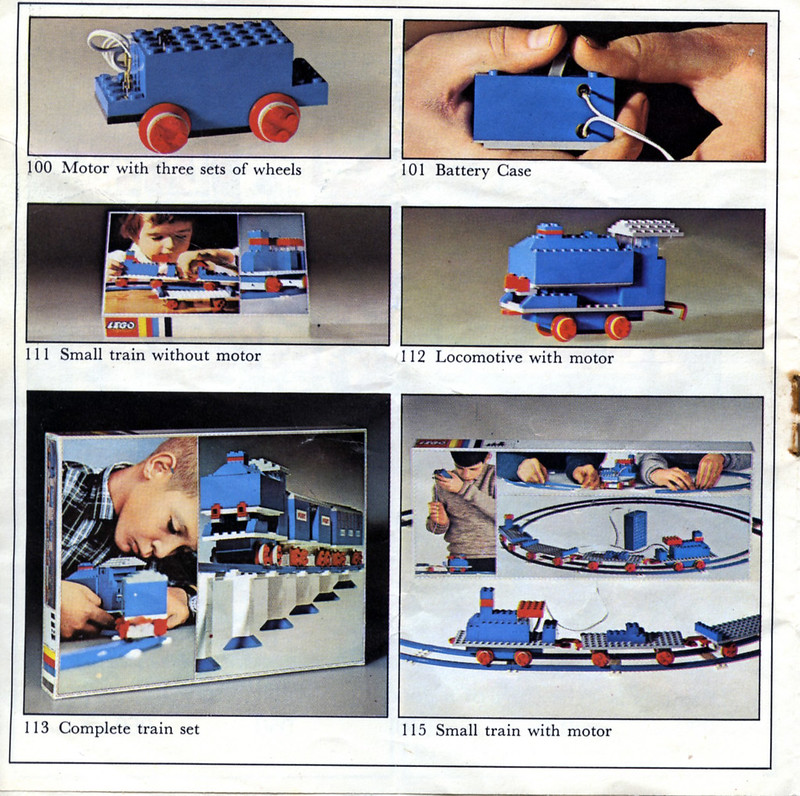 Hot on the heels of the first wheel came the LEGO train. The original wheels were given flanges to run on the blue plastic rails, and a battery box -- taking three C sized batteries -- and 4.5v motor were introduced to power the locomotive.
Hot on the heels of the first wheel came the LEGO train. The original wheels were given flanges to run on the blue plastic rails, and a battery box -- taking three C sized batteries -- and 4.5v motor were introduced to power the locomotive.
The original models were crude but it was not long before sophisticated models became available, as I discussed in last week's article about 1968.
1968: The first LEGOLAND park opens
 Even in the 1960s the popularity of the product led to many people making the pilgrimage to Billund, the place of its birth.
Even in the 1960s the popularity of the product led to many people making the pilgrimage to Billund, the place of its birth.
Schools and other organisations could arrange factory tours, during which they could marvel at giant-sized models made by the company's first artistic model designer, Dagny Holm.
Godtfred Kirk Christiansen's modest plans to house the models in a small permanent open air exhibition nearby for more people to enjoy soon escalated in scope to include many aspects of the park that are still there today: miniland, upscaled LEGO train, traffic school, theatre and Indian encampment. When the park opened in 1968 some 625,000 people visited in the first year instantly making it Denmark's second most popular tourist attraction after Tivoli Gardens in Copenhagen.
When I Googled for images of LEGOLAND in 1968 I came across the absolutely fascinating British Pathe documentary about Denmark and the park in particular on YouTube which was made the year the park opened. It really is a thrill to watch. The LEGOLAND part starts at about 1:30.
1969: Large blocks for small hands
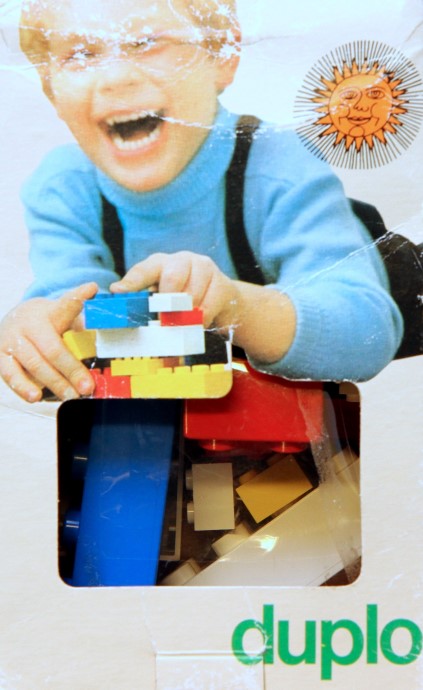 LEGO had been making large bricks for small children since the 1950s but those made before 1969 were not compatible with regular LEGO.
LEGO had been making large bricks for small children since the 1950s but those made before 1969 were not compatible with regular LEGO.
In 1969 a new range was launched, which had dimensions that were double that of regular bricks, thus were eight times the volume.
In Europe and Canada the name Duplo was used for these new sets while in the USA they were branded Pre-School for a time, like those that were made before. [2]
The Duplo name has been used ever since, apart from a few years in the early 2000s, at the time when the company nearly went off the rails, when it was re-branded Explore. It was a disastrous marketing decision which caused confusion among consumers and led to a decline in sales.
The 1960s was thus an eventful decade, in which the company turned from one still making wooden toys in a sleepy town in Denmark, to one whose ever more sophisticated products were available throughout the world. There is no doubt that the decade was an important period in the company's history.
Much of the information in this article has been obtained from the book 50 Years of Play, published by the LEGO Group on the occasion of its 50th anniversary in 1982.
[1] The unofficial LEGO sets/parts collector's guide, chapter 60, Gary Istok, 2014
[2] The unofficial LEGO sets/parts collector's guide, chapter 21, Gary Istok, 2014
51 likes
24 comments on this article
Love the documentary!
Great article.
Great stuff as usual Huw!
Great article Huw! Thanks!
Great job huw!
"Although the first ABS parts found their way into 1963s products, it would not be until 1972 that it was phased out completely. [1]
ABS is still the primary plastic in use today."
I find these two statements confusing.
You just HAD to use the creepiest photo for Duplo. Now I'm scarred for life
^^ statement clarified, thanks.
You could walk in the streets of miniland back then!?
Oh, I really enjoy reading these type of articles. Thank you for writing it!
Great job, Huw! I really appreciate the effort that goes into these articles!
Great video - thanks
That was a great video to find. Makes me wish more than ever that I could see that original park first hand.
Very informative, thank you!
Wow, so much of that would never fly now. People freely walking between the models? No fences? Kids driving go-karts that aren't on tracks, pedestrians on the track, no seatbelts? I love that they could just build a fun place back then! I also noticed the girl building the model toward the beginning didn't seem to be using any instructions--I think she just looked at a building and then placed parts. So cool!
Looks like I missed quite a decade! After watching the video of 1968 there was a link to a video of Legoland Billund in 1973. In that one I recognised a lot of what I saw when I first visited in 1981 or '82. The safari, the boats, the Thai temple...
I suspect a lot of the action was staged for the filming. I can't see them letting little kids run around in between buildings, even in the 1960s...
That documentary is great. It's in that classic British intonation, constantly referring to Legoland as 'Dreamland' and of course many of us would think so too. The early Space Age and Castle Miniland models were outstanding, particularly given the simplicity of the bricks at the time. And of course the boats still run on a pulley system which often seems to break down! Seemed like the early driving school was mostly a cycling school?
^^ I can remember visiting model villages in the UK (like the one in Southport, which may or may not still exist) and being free to wander up and down the mini streets. That would've been around late-60s/early-70s. With that in mind, there's a fair chance that LEGOLAND had a similarly relaxed setup. No chance of it today with all the health and safety rules we have!
Excellent article, Huw, and that video's an absolute gem!
Those were the days!
Brilliant! Legoland in 1968 seems so much better than today :-)
Not sure about the gearing on those bikes in the video!
Amaizing documentary, glad to have read it.
The worst Duplo picture ever ;p
lol yeah, he looks like he's possessed